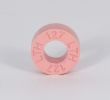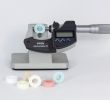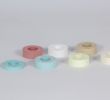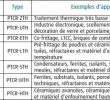PTCR temperature measurement rings
Process Temperature Control Rings (PTCR) are a reliable and accurate temperature indicator, an important parameter in the manufacture of tiles, sanitaryware, refractories, porcelain, technical ceramics, etc. They measure the thermal energy received by the products during firing or sintering. The temperature of a product can be measured accurately to +/- 3 °C due to the diameter of the ring at the kiln exit. These rings are effective over a range from 560 °C to 1750 °C. There are different types of rings each covering smaller temperature ranges, allowing them to target certain areas of application.
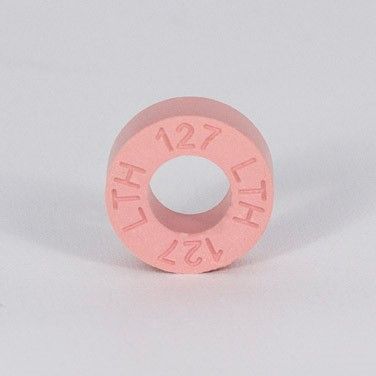
Why use PTCR rings?
Firing accuracy is a critical factor in the production of high performance ceramic products such as alumina. The level of rigour of this firing has an effect on production costs and the quality of the end products. This requires products that can accurately measure high temperatures. In order to optimise the firing process, it is necessary to have both accurate temperature measurement and homogeneity of the temperature in the kiln. The aim is to measure the temperature of the product and not of its environment. In this respect, most conventional methods are limited. For example, the thermocouples used in the ceramics industry take into account the temperature of the environment in the kiln at a specific point, i.e. the heat transmitted by radiation, but not that transmitted by conduction or convection via the firing equipment or other means.
Monitoring the cooking process using PTCR temperature rings is a method of accurately determining the heat received by the product throughout the thermal cycle. They can be placed anywhere in the oven, without necessarily being in contact with the product. These rings, produced by FERRO in France, can be used in a conventional furnace as well as in a pass-through furnace and can be used in several atmospheres. They were originally intended for the electronics industry but are now used in all areas where precise control of the firing process can be useful.
PTCR rings can also be used to control temperature uniformity. By placing several temperature rings in the kiln, it is possible to map the temperature uniformity at the end of the firing process. In this way, "hot" and "cold" zones can be identified and the baking process can be optimised by adjusting the heat sources. This improves the efficiency of the kiln and the quality of the finished products.
How do the temperature measurement rings work?
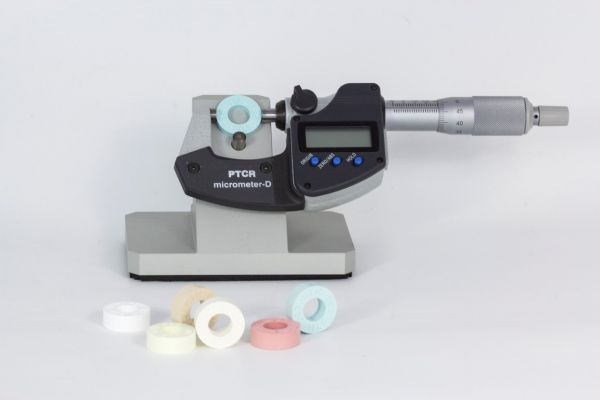
The rings can be placed freely in the oven heating the product whose exact temperature is to be measured. When exposed, the PTCR rings shrink due to radiation, convection and conduction heat. After firing, the shrinkage of the ring is measured with a micrometer. This shrinkage is then converted using tables specific to each model. This method then returns a single parameter: the ring temperature (RT), which allows simplified processing of the results. FERRO's rings thus offer a simple and safe way to measure temperature and temperature uniformity in a furnace. They are ideal for temperature mapping or for statistical production control (by placing a few rings in the furnace at each charge).
What are the advantages of PTCR temperature rings?
PTCR rings are an excellent solution for measuring the temperature at which a product is heated in a kiln or other oven, taking into account all heat flows involved (radiation, but also convection and conduction). There are other methods of measuring the temperature of the product rather than its surroundings. These are pyrometric devices used in kilns during the firing of ceramics to assess the temperature and homogeneity of the ceramic. The elongated cones with a triangular base are arranged in groups of at least three with the pieces to be fired in a kiln. The different cones have different melting temperatures, depending on the number of straight, tilted or even melted cones, the temperature can be estimated visually. However, this method gives an operator's assessment and not a precise and repeatable result.
The temperature rings therefore have a double advantage: they are able to measure the temperature of the product being cooked (not the air in the oven) and they do so very precisely, the results obtained are exact and numerical. The measurement is accurate to +/- 3° TA (ring temperature). This technique can also be used for low cost quality control. Indeed, by using them regularly, the rings can be used to detect any deviation over time, which can be quickly acted upon. This reduces or eliminates time-consuming and costly quality checks.
What are the different types of PTCR rings?
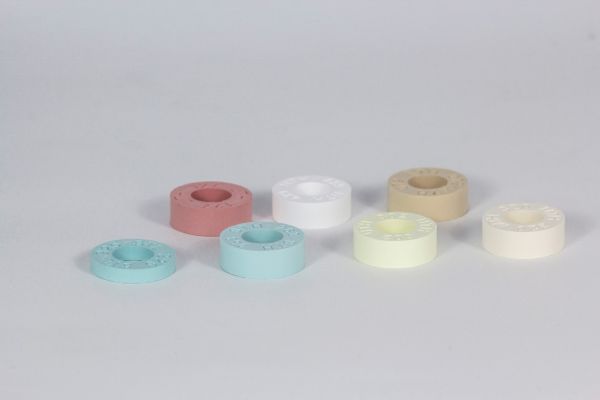
FERRO produces different ranges and types of PTCR rings in order to best measure different temperature ranges between 560 °C and 1750 °C. There are 7 types: ZTH, UTH, ETH, LTH, STH, MTH and HTH. The different types of rings can be recognised by their colour, the inscriptions engraved on them and their varying thickness. These different ranges allow the measurement of specific temperatures and are therefore adapted to the needs of particular areas. Here are the different types of rings, the temperatures at which they can be used and examples of the areas in which these temperatures and therefore these rings can be found.
| Temperature range (°C) | Types | Examples of application |
| 560-660 | PTCR-ZTH | Very low temperature heat treatment |
| 660-900 | PTCR-UTH | Very low temperature heat treatment Electronics industry, glass hermetic seals, PTCR-UTH Glass and porcelain decoration, annealing furnace |
| 850-1100 | PTCR-ETH | Co-sintering, LTCC, building bricks, tiles |
| 970-1250 | PTCR-LTH | Pre-sintering of powders and ceramics, pottery, bricks, PTCR-LTH tiles, refractories and low temperature kiln furniture |
| 1130-1400 | PTCR-STH | Condensers, ferrites, insulators, sanitary ware, dishes, grinding wheels, refractories and kiln furniture |
| 1340-1520 | PTCR-MTH | Ferrites, substrates, insulators, porcelain, technical ceramics, refractories and kiln furniture |
| 1450-1750 | PTCR-HTH | Advanced ceramics, technical ceramics, refractories and high temperature kiln furniture |
All rings are produced by FERRO in Saint-Dizier, France under ISO 9001:2000 and ISO 14001 certification.





